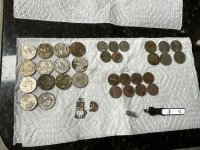bigrig40
Bronze Member
I am fairly new to beach/shallow water hunting and would appreciate any tricks of the trade so to speak.Me and knorrski found a few rings and coins late last year and would like any feedback to maybe find a few more.We live in Ind.and we hit a few freshwater beaches around here and we use whites MXT and DFX.
bigrig
bigrig
Upvote
0


 .
. !
!





